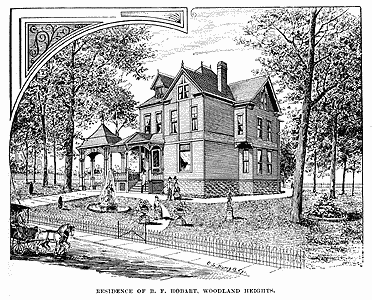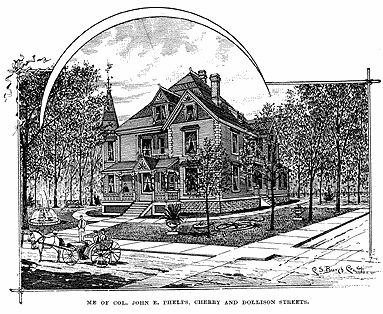SPRINGFIELD, MISSOURI AND SURROUNDINGS • 1889
(previous page) is probably lower than any other city of its size in the United States. First in importance among the influences that have ministered to the remarkable growth of Springfield are its RAILWAY FACILITIES which, considering, the extent and character of the two trunk systems involved, are among the best enjoyed by any city in the Southwest. THE ST. LOUIS & SAN FRANCISCO Railway Co. is one of the strongest corporations in the Southwest, with its main line reaching from St. Louis, via Springfield, into middle and Southwest Kansas, and branch lines from Springfield north to Bolivar, on its ultimate route to Kansas City, and south to Chadwick, on its projected extension to Little Rock. From the main line at Monett, in Southwest Missouri, the southern branch of this road is already completed through Arkansas, via Ft. Smith, into North Texas, on its way to the Gulf. What is ultimately to be the main line of this great corporation to the Pacific is now being rapidly laid westward through the Indian Territory.
The system above outlined already embraces 1460 miles of completed railway, giving Springfield the advantages of its extended Southwestern connections into Texas and Arkansas; its equally extensive connections with the interminable railway systems of Western Missouri and Kansas, and with the great Eastern, Northern and Southern systems radiating from St. Louis. It places Springfield on what is soon to be the most direct and popular Southern route from the Mississippi to the Pacific Ocean, and the location of its general shops and central division station here, has, from the date of its coming in 1870, been a powerful factor in the growth of the city. The “Frisco” is a strong, aggressive, advancing, ably managed and finely equipped line, whose projected extensions will give the city access to every point of importance in the Southwest. THE KANSAS CITY, FORT SCOTT, AND MEMPHIS Railroad, which was completed to this city in 1882, and is popularly known as the “Gulf Route,” is one of the most important north and south trunk lines in the country, entering from Kansas City, southeast to Memphis on the Mississippi River, and thence to Birmingham, Alabama, having with these two cities connections with the entire railway systems of the South, and at Kansas City, Springfield and Fort Scott, connections with the great railway systems of the West and North. Eighty miles southeast of Springfield, at Willow Springs, the Current River Branch of this system is laid through the finest pine and hardwood regions of Southern Missouri, to a point in Carter County, where it connects with a well-known line to Cape Girardeau, on the Mississippi. This Current River Branch will soon be extended to Poplar Bluff, on the Iron Mountain road, where it will connect with another Mississippi line to Cairo, thus giving it connections with this great water way at three important points.
From Ash Grove, twenty miles west of Springfield, a branch of this road is laid through one of the richest farm and coal regions in Missouri to a junction with the main line at Olathe, near Kansas City.
Another branch leads from Fort Scott to Jolin and Webb City, traversing the rich Cherokee coal fields, and terminating in the heart of the great lead and zinc district of Galena, Webb City, and Joplin. A fourth branch is laid from Arcadia, on the main line to Cherryvale, in Southern Kansas, and a fifth one runs from Miami, on the main line, to Rich Hill and Carbon, ending in the richest bituminous coal fields of the West. This splendid and rapidly growing “Gulf” system, recognizing the importance of Springfield as a trade and industrial center, has also located its general shops and central division station and offices here, and, as noted in the foregoing pages, has given mighty impulse to the growth and prosperity of this favored city. The “Gulf” people are proverbial for their enterprise and fair dealing with the public, and with its fine equipage and liberal progressive management, the “Gulf,” or “Nettleton System,” as this line is popularly designated, is unquestionably the most popular north and south route in the middle Union. It has already 1200 miles of road in operation, and is steadily pushing its way to the conquest of new territory.
These two fine trunk systems are worth to the city a dozen ordinary lines, and with their far reaching connections give it easy access to every portion of the country. There are several PROSPECTIVE RAILWAYS as sure to build to this central city within the next five or six years, as the sun is sure to shine. One of the earliest of these will be THE CHICAGO, HANNIBAL, AND SPRINGFIELD road, for which surveys have been made from the Imperial City of the Lakes to Springfield, across the garden of Illinois to Hannibal, and thence southwest to this city, over some of the richest farm, bituminous and cannel coal, lumber, lead, zinc and iron districts in Missouri. Ample provision has been made for the immediate construction of this line, which is to be extended to the Gulf, and the building of which will give splendid new impulse to every vital interest of the city. Indeed it is hardly possible to designate a new route of greater importance to Springfield than the one last named. Whether it shall be built in the interest of the Alton, Burlington, Rock Island or Missouri Pacific roads, is a matter of little moment, for sure as fate the first break made for this city by either line will find the other three following hard after. That Springfield is to become a FORMIDABLE RAILWAY CENTER is “on the cards.” It has strategic importance, size and control of material forces that no railway (next page)
Page
1 | 2 | 3 | 4 | 5 | 6 | 7 | 8 | 9 | 10 | 11 | 12 | 13 | 14 | 16 | 17 |
18 | 19 | 20 | 21 | 22 | 23 | 24 | 25 | 26 | 27 | 28 | 29 | 30 | 31 | 32 | 33 | 34 | 35
Springfield 1889 Home | Keyword Search | Engravings Thumbnails | Local History Home


